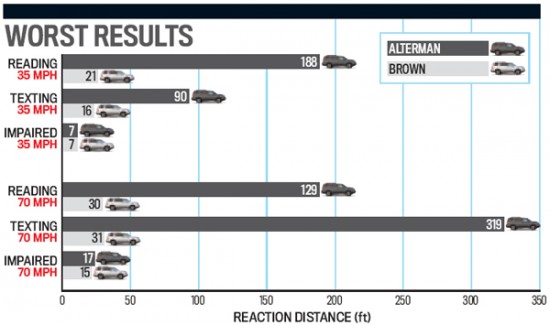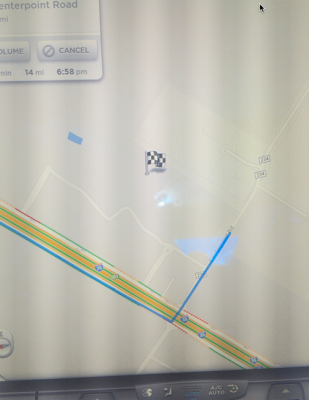A mentor recently mentioned, in passing, that he stopped riding motorcycles when cellphones came out, as he noticed the average driver distraction level had gone way up. He said ‘its like everybody’s drunk’.
There’s lots of ways to be an impaired driver: physical or mental fatigue, chemicals (legal and not), emotional extremes, etc. (this is not an exhaustive list). What I want to focus on here today is a very controllable risk factor, divided attention.
A quick internet search turned up some original research from Car and Driver on the subject of texting while driving compared with actual alcohol impaired driving, and the results are shockingly worse than I would have thought. From their (admittedly limited but well done) study, texting is way worse than being at the legal alcohol limit, both reading and writing.
How bad? This bad (please read the article; it’s short, well written and will fill you with any leftover dread you don’t get from looking at their illustration):

I, like C&D, would like to point out that this doesn’t make driving under the influence okay, it doesn’t. What it does do is put into perspective the astonishing diminution of skill with divided attention between driving and texting. It’s 100 times worse when you consider that they knew they were being tested, and still had these results. None of us get into a car and say ‘my reaction times will be severely tested today, I must be hypervigilant’.
Apparently we should, and just drive with this in mind: everybody’s drunk, or worse. (And pull over, park safely, then text – we’ll all be glad that you did)



My standard technique is to drive as if my car is invisible and everyone else on the road is unconscious. I rarely see any evidence to the contrary, and it’s a delight when I do.
I feel a lot safer on the race track than on the road because I know that every racer has excellent situational awareness, and I can almost always predict what everyone is going to do next. Having driven race cars for so many years, I have been hard-wired to maintain the situational awareness required when you are never more than 3 seconds of distraction away from death. That became a real problem during flying lessons when cross-country flight log entries and in-flight calculations required looking down for more than a few seconds. I just couldn’t do it.
If you want a giant shock and a lesson about how proficient drivers can be, go drive in England.
Possible source of bias: the passenger triggered the red light when he wanted to. It’s likely that he waited until the driver’s eyes were diverted from the road. A blind experiment would have made the timing random. In other words, the experiment may have compared the worst case texting time against the best case impaired time. Why best case? My theory is that moderately impaired drivers do quite well when they are paying attention. The problem happens when they are distracted, and they are easily distracted.
That said, driving and texting is probably more dangerous than those ladies I sometimes see on the Houston’s Katy road applying their eye shadow looking into the rear view mirror while doing 80. At least they are looking in the right general direction.
Additional observation: If you ever meet the Alterman of That C&D experiment and he offers to dive you somewhere, politely refuse.
Freddy Hill,
I get your point about trigger bias, but the car braking in front of the test subject wouldn’t wait until their attention was undivided, either.
Actually, I’m told there are several studies showing that having a slight buzz on actually makes most drivers hypervigilant, and therefore their reaction times get better, with the understanding that that’s in test, not in The World.
A guy on my street with a sport bike routinely texts as he approaches the traffic light– makes me nervous as heck! I even saw him texting the day after a much-publicized fatal accident in which a biker wasn’t noticed for hours after dying because he’d gone into a drainage ditch.
I’m pretty convinced that cautionary tales don’t really work, they just add melodrama so the numb voyeurs can feel something for a minute. Grr.
I seriously think most drivers forget physics the moment they hop in their cars.
I would actually recommend everyone ride a motorcycle for a bit (take the class, buy the gear, be smart about it). The bike’s been a better defensive driving teacher than any class I’ve had…you’re pretty much forced to learn the patterns that crappy drivers have; after some time on two wheels driving a car becomes immeasurably safer. Slowing down when it starts to drizzle, noticing the lone under-pressure tire on a car, checking the rear view as you slow at a red light…it all becomes second nature. Pretty useful habits.
The basic issue is that there is no such thing as multitasking. You can only task-switch, slowly or quickly, and in the end your performance on all tasks is at best fair.
The problems with alcohol or other intoxications is more global, with a dulling of the senses, slowing of reaction times, and adversely affecting judgment. Probably formal tests underestimate the dangers of intoxication, since in practice, one can for a time at least be able to focus attention when you know that you are being evaluated.